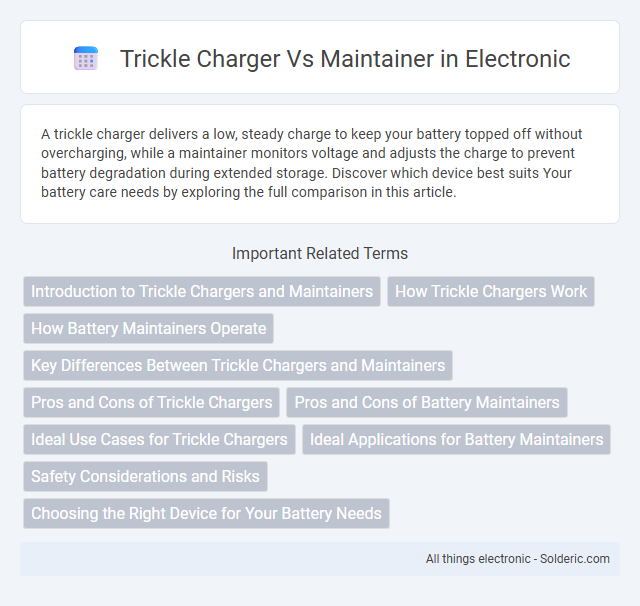A trickle charger delivers a low, steady charge to keep your battery topped off without overcharging, while a maintainer monitors voltage and adjusts the charge to prevent battery degradation during extended storage. Discover which device best suits Your battery care needs by exploring the full comparison in this article.
Comparison Table
| Feature | Trickle Charger | Maintainer |
|---|---|---|
| Purpose | Slowly charges a battery | Keeps battery fully charged without overcharging |
| Charging Rate | Low, steady current (around 1-2 amps) | Very low current, intermittent charge |
| Usage Time | Limited use; not designed for long-term connection | Safe for long-term, continuous use |
| Overcharge Protection | Usually lacks automatic shut-off, risk of overcharge | Built-in smart charging and overcharge prevention |
| Ideal For | Recharging drained batteries | Maintaining battery charge over long storage |
| Battery Types Compatible | Mostly lead-acid batteries | Lead-acid, AGM, gel, and lithium batteries |
Introduction to Trickle Chargers and Maintainers
Trickle chargers provide a low, steady current to recharge batteries slowly, preventing overcharging while restoring battery life over extended periods. Maintainers, on the other hand, supply a regulated, low amperage current specifically designed to keep fully charged batteries at optimal power without causing damage or excessive charging. Understanding the differences between a trickle charger and a maintainer ensures you select the right device to extend your battery's lifespan and maintain its performance.
How Trickle Chargers Work
Trickle chargers work by delivering a low, steady current to a battery, which prevents it from discharging while avoiding overcharge damage. They continuously supply just enough power to keep the battery fully charged without causing excessive heat or wear. This makes trickle chargers ideal for long-term maintenance of batteries in vehicles or equipment that are not used frequently.
How Battery Maintainers Operate
Battery maintainers operate by delivering a low, steady charge that prevents battery drain and compensates for self-discharge, ensuring the battery remains at optimal charge without overcharging. They continuously monitor the battery's voltage and adjust the charging current accordingly to maintain a full charge over extended periods. This precise regulation extends battery life and keeps it ready for use in vehicles or equipment during storage.
Key Differences Between Trickle Chargers and Maintainers
Trickle chargers deliver a low, steady current to slowly recharge a battery, preventing overcharging by turning off or switching to pulse mode once full capacity is reached. Battery maintainers, on the other hand, provide a smart, automatic charge that adjusts voltage and current to maintain optimal battery health over extended periods without the risk of damage. Key differences include charging control, current regulation, and suitability for long-term battery storage or infrequent vehicle use.
Pros and Cons of Trickle Chargers
Trickle chargers provide a slow, steady charge to maintain battery levels, preventing overcharging and prolonging battery life, especially for vehicles in storage. Their low amperage makes them ideal for long-term use, but they may not fully charge deeply discharged batteries quickly. However, trickle chargers require careful monitoring to avoid undercharging or damaging sensitive batteries, which can be a limitation compared to advanced maintainers.
Pros and Cons of Battery Maintainers
Battery maintainers offer the advantage of preventing overcharging by automatically regulating the voltage, which extends battery life and ensures readiness for use. They are ideal for long-term maintenance of vehicles stored for months since they keep the battery at an optimal charge without manual intervention. However, maintainers tend to be more expensive than trickle chargers and may not be necessary for short-term battery charging needs.
Ideal Use Cases for Trickle Chargers
Trickle chargers are ideal for maintaining battery charge in vehicles that are used infrequently, such as classic cars, motorcycles, and seasonal equipment, preventing battery drain over long periods. They deliver a low, steady charge, making them perfect for long-term storage without the risk of overcharging. Your battery's lifespan is enhanced by avoiding deep discharges, ensuring reliable starts when the vehicle is next in use.
Ideal Applications for Battery Maintainers
Battery maintainers are ideal for long-term battery care in vehicles or equipment that are used infrequently, such as classic cars, motorcycles, or seasonal lawnmowers. They provide a low, steady charge that prevents battery discharge without the risk of overcharging, making them perfect for maintaining battery health over extended periods. Your battery's lifespan is preserved by using a maintainer to keep it fully charged and ready for use at any time.
Safety Considerations and Risks
Trickle chargers provide a continuous low-amperage charge, which can risk overcharging and battery damage if not properly monitored, while maintainers use smarter technology to prevent overcharge by regulating voltage automatically. Safety concerns with trickle chargers include potential overheating, electrolyte loss, and reduced battery lifespan, whereas maintainers reduce these risks with built-in protections against short circuits and reverse polarity. Choosing the right device ensures your battery remains safe and operational without the hazards associated with improper charging.
Choosing the Right Device for Your Battery Needs
Trickle chargers supply a low, steady current to gently recharge a battery, ideal for occasional use and small batteries. Battery maintainers go beyond charging by monitoring voltage and providing automatic pulses to prevent overcharging, making them suitable for long-term battery upkeep, especially in vehicles stored for extended periods. Selecting the right device depends on your battery type, usage frequency, and storage duration to maximize battery lifespan and performance.
trickle charger vs maintainer Infographic

 solderic.com
solderic.com